DISCLAIMER
Currently, very few polyphasic sleepers have used the mnemonic techniques to enhance their learning experiences, thus, this guide will attempt to demonstrate:
- what the specific techniques are,
- how polyphasic sleepers can take up this learning tool as a way to boost motivation by using the extra waking hours for more intensive learning.
It is also worth noting that the adaptation period with sleep deprivation can hinder the efficacy of these methods; thus, the potency of the mnemonic techniques in this blog may deliver worse results than expected.
Introduction
Mnemonic techniques are powerful tools that can improve memorization1. For students, using memory techniques can help drastically reduce the total time spent studying and score higher on exams2. Therefore, mnemonics, along with the Method of Loci, are viable alternatives for teenagers and students; especially if they are willing to trade some sleeping hours for studying hours by utilizing polyphasic sleep.
The following mnemonics methods are not only usable on their own, but can also be combine with the Method of Loci or Spaced Repetition Systems for even greater benefits.
Content
Different types of mnemonics
Mnemonic techniques are memory tools that aid in memorization3. Every mnemonic device is based on association. The associations facilitate recalling complex information4. Later, these associations can combine with easier memorable mental images, rhymes, songs, stories and/or locations. Each learner can apply various types of mnemonics, so choose a method that works best personally.
Memorizing Numbers
Memorizing numbers can be a challenging task without the use of any mnemonic techniques. A mnemonic tool that students should use for memorizing numbers is called the Major System.
With the Major System:
- The first thing to do is transform numbers from 0-9 into consonant sounds5.
- Then, add vowels to form a word. This word will aid in memorizing the number. Splitting the number and building two words is also possible if it is a preferred choice.
- All learners need to do beforehand is to memorize the corresponding consonant for each number. They can also assign a number with a consonant sound or use the most common Major system.
Example
0= s, z
1= t,d
2= n
3= m
4= r
5= l
6= sh, ch, … (same sound)
7= k, g
8= f, ph
9= p, b
Example: A learner wants to memorize when Buckminster Fuller invented the Dymaxion Schedule (1943).
- It is important to establish a link to Buckminster Fuller with 1943 first.
- Then, create an easily memorable image that will aid in the memorization process.
- In step 1, convert both things into something visible. If Buckminster Fuller’s physical appearance is in memory, converting him into something more memorable is not necessary.
- Now, convert 1943 into a word, using the Major System. Possible words are: table-rem.
- In this example, imagine Buckminster Fuller taking a nap on his table or dreaming about something on a table.
- Visualize the image for about ten seconds. Alternatively, associating Buckminster Fuller with Ted Mosby is also a possible option; both of them are architects after all. Use him as an image in the mind.
- Once familiar with this system, learners can memorize numbers without having any issues.
Person-Action-Object (PAO) System
The PAO System is an advanced system for memorizing numbers6. With this system, it is easier to remember larger numbers, but learners need to invest more time beforehand. It evolves naturally from a simpler number to letter system like the Major System or the Dominic System. Memory athletes know this method by hand and often use it7.
- With this system, learners create mental images by associating two digit numbers with one person, one action and one object.
- The image is created by visualizing the person for the first two digits, then the action for the next two digits, then the object for the last two digits for the mental image.
- This system allows memorization of six digit numbers with only one mental. If it is a number with more than six digits, like pi, it is possible to store the mental images on a loci-route/ in a memory palace.
How to create the first PAO-System:
As mentioned previously, the PAO-System is created by aligning two digit numbers (00-99) with one person, action and object each.
- First, memorize an easier number to letter system. This will enable every number (00-99) to be translated into initials.
- The next step is to find people or characters from movies that have these initials. Afterwards, associate an action and an object with each initial/ person.
Example: Number 21 is transformed into a Person-Action-Object System, and has already been memorized by the major system. The initials for 21 are “n” for the first digit, “t” or “d” for the second digit. A possible person could be Nikola Tesla. Now, start associating that person with an action and an object.
Memorizing Vocabulary
Linking Method
Memorizing vocabulary usually revolves around creating a mental image that contains the new word itself and its meaning8.
- It is necessary to imagine the mental image for about 10 seconds before moving on.
- The new word is usually visualized as an already known word that sounds similar to the new one or by association.
- The word’s new meaning is usually easier to visualize and should not require any associations before incorporation into the image.
Example: Schlafen (to sleep):
“It’s not so easy to form an association with this word. A key image is of two city-types standing over a man who has fallen asleep. One of them is laughing loudly, the other is saying, ‘sssshhhhh, you’ll wake him’. ‘Sssshhhhh’ and ‘laughing’ are roughly equivalent to Schlafen.”
This method may seem very complicated, but it is highly effective and easier than one would expect.
- It is important to remind oneself that both the meaning and the new word have to be parts of the mental image.
- Fortunately, some authors have established how it works and written dictionaries that already contain these mental images.
- For an even better outcome, automate the learning process by combining this method with a spaced repetition system like Anki or Supermemo.
Spaced repetition
Spaced repetition systems are flashcard-based systems that make use of the forgetting curve and space the repetition intervals right before learners would forget something.
- The intervals enlarge after each successful repetition and space accordingly to the review of the recall as either “again”, “good” or “easy” most of the time.
- The algorithms behind these systems are highly complex.
- The best known type of algorithm is the SuperMemo algorithm, which has been shown to increase the average examination points of students9. Both Anki and the newest version of Supermemo use different types of the SuperMemo algorithm.
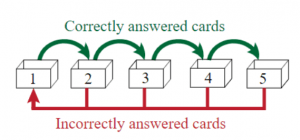
Downsides
How the SuperMemo algorithm works is explained below (and why Anki and Supermemo are superior to Quizlet etc.). It is important to note that simpler programs do not have a review system and rely mostly on the Leitner-System:
The problem with this system is obvious:
- It shows the flashcards too often,.
- It does not space each flashcard individually, yet relies on a fixed system.
- Thus, it does not differentiate between hard-to-remember and easy-to-remember flashcards. Nor does this system space the intervals at the latest possible time, before learners would forget it.
- All in all, this makes the system highly inefficient, though it was a good alternative for the standard rote learning in the non-digital age. Supermemo-Algorithms make use of a review system, that lets the algorithm learn how difficult it is to remember each flashcard:
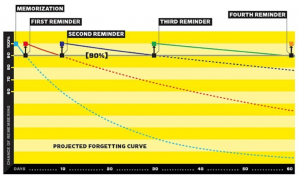
Moreover, the modern Supermemo-Algorithms individuate between graduated and new flashcards.
SuperMemo-Algorithms are superior to rote learning and fixed repetition systems.
- This is because they not only make use of the forgetting curve but also allow the algorithms to space reviews right before learners would forget learned materials. This process decreases the number of repetitions.
- This effectively reduces the total time spent studying and makes use of the spacing-effect10. However, they also account for how difficult it is to remember each factum and place the repetitions accordingly.
- Additionally, there are many different SuperMemo-Algorithms. The spaced repetition software Anki is based on the SM-2 Algorithm, while the Version of the SuperMemo defines what SM-Algorithm is used.
Alphabet Peg System
Alphabet Peg Systems enables learners to memorize up to 26 pieces of information. They make use of the fact that everyone can recall the alphabet, which is a given route. Before learners are able to use the alphabet for better memorization, each letter first has to be associated with something. This can either be a list of animals or a list of jobs with their first initial.
Example:
A- ant
B- beaver
C- crocodile
D- dolphin
E- elephant
…
After the list is complete, it is possible to use it for every type of information, even shopping lists. To achieve this, learners have to let their mnemonic peg interact with the new information and then visualize the outcome.
Benefits of using mnemonics
There are numerous benefits of mnemonic techniques.
- The most obvious and important of which is to drastically reduce the total time spent on studying with proper use7.
- In addition, it is apparently more fun than mindless rote learning; it has the potential to enliven even boring topics. Using mnemonics and better studying techniques also often leads to much less frustration and anxiety11; as a result, it creates more exciting ways to learn.
- Learners also don’t often experience failures as much as in common rote learning, since the information is likely to stick for years with good mnemonics and only few repetitions.
- Learners who make use of Mnemonics have been shown to perform better on exams11. The reduction of the total time spent studying can also reduce the urge of young polyphasic sleepers to attempt sleep reducing schedules.
- Applying mnemonics on a daily basis can enrich social life. There are mnemonic types that assist in the memorization of names and faces. Thus, remembering important appointments also becomes easier with the use of mnemonics.
The best of both worlds: Utilizing mnemonics in combination with spaced repetition systems
Since Spaced Repetition Systems and mnemonics have both been shown to be an effective learning method2,9, it is wise for learners to make use of both.
- The mnemonic techniques can help learners get the information into long term memory right away.
- The Spaced Repetition Systems make sure the information is not forgotten. It can still aid in transferring the facts into long term memory, if the mnemonics alone are not enough.
- The combination of both mnemonics and Spaced Repetition is nothing new; thus, the Super Memo website advocates for using mental imagery and mnemonics12.
The easiest way to implement this combination is to either create Mnemonics while transferring the data learners want to memorize into a spaced repetition system. In addition, if students are fans of batching, start with creating mnemonics for every factum, transferring everything into a Spaced Repetition System and start rewinding. The viable ways to implement this into a daily routine together with polyphasic sleeping are in the following section.
Potential applications in polyphasic sleeping
Owing to the importance of sleep in memory consolidation13, undisturbed studying and refreshing breaks, polyphasic sleepers have advantages over monophasic sleepers in terms of studying. There are different ways polyphasic sleepers can utilize multiple mnemonic techniques to optimize their study sessions.
Scheduling study sessions before naps
All polyphasic schedules contain both REM and NREM2 after the adaptation process.
- Especially REM sleep is responsible for elaborative encoding13, which is the type of memory encoding that goes with mnemonics3.
- Furthermore, one can optimize this process by placing the study session in a night wake period, which facilitates focusing and studying without interruptions.
- However, the studying period can also be before a daytime nap.
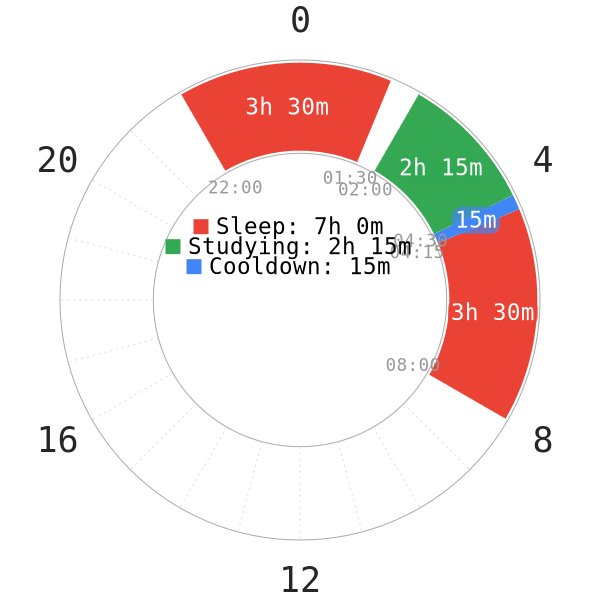
The second core sleep of Segmented schedule contains abundant REM sleep, which is a powerful tool to boost elaborative encoding capacity. Alternatively, students could also divide the study sessions into two different segments, one of which is reserved for creating mnemonics and the other is for rehearsal, as shown in the example below.
Pomodoro Technique & Mnemonics
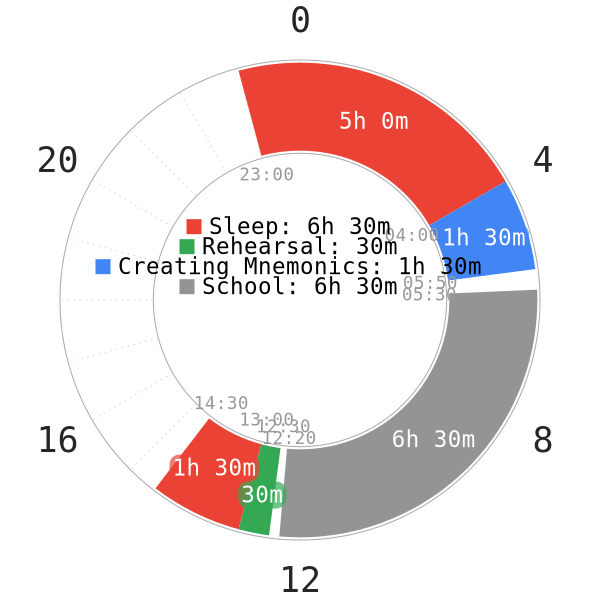
The second Siesta core contains both SWS and REM sleep, which further helps with elaborative encoding13. Getting both these vital sleep stages also helps with memory consolidation, declarative and procedural memory functions. Additionally, scheduling this study method can be improved even further, when learners can utilize the Pomodoro Technique.
The first 2-3 Pomodoro cycles can be used to create mnemonics for the study material and the last 1-2 Pomodoro cycles can be used to recite learned materials
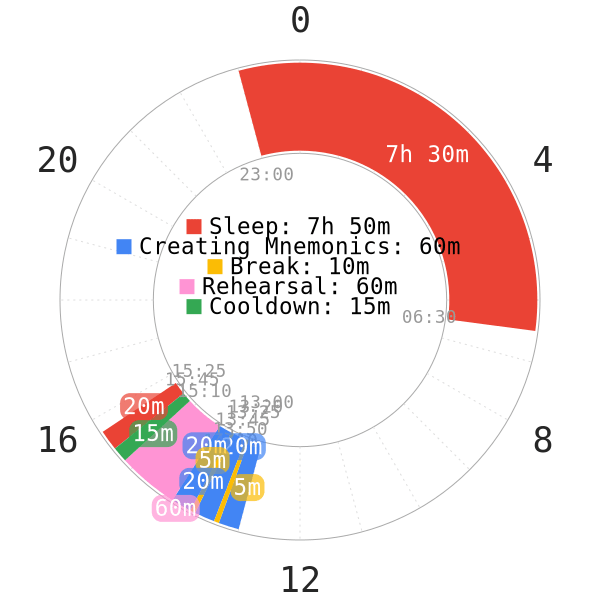
Using the last Pomodoro cycle for recitation and placing it right before the nap will assist the encoding process of the episodic memory13, especially if done right before a REM nap at early hours in the day.
Lastly, students can also combine mnemonics, spaced repetition, the Pomodoro technique and polyphasic sleeping effectively. Creating mnemonics and converting them into flashcards is possible during the Pomodoro cycles. In the meantime, the 20-minute default break can be traded for some sleep and the daily review can be scheduled before a nap. This automates the rehearsal procedure and ensures that learners can keep the information for the long term by perfectly spacing the repetition intervals for each flashcard.
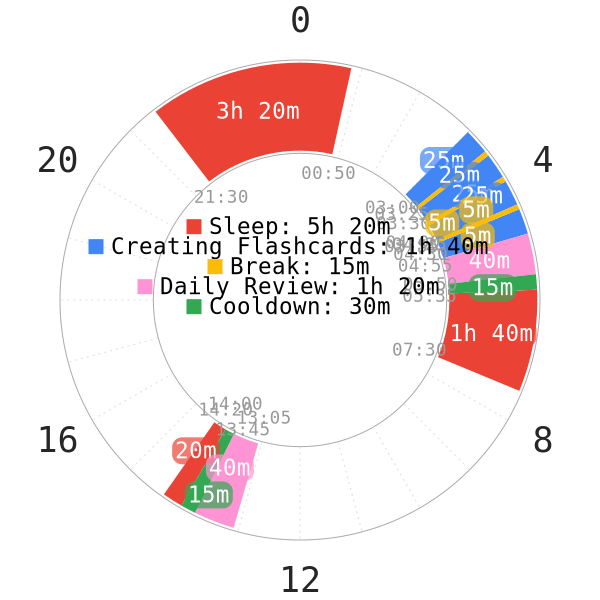
The daily review period is scheduled right before the REM-heavy core sleep on DC1, which boosts the ability to remember procedures by repetition8. Alternatively, if EEG readings show that the nap contains some amount of REM sleep, preparing for another set of mnemonics around that time is also recommended
Conclusion
Overall, the mnemonic techniques are strong memory tools that strengthen memorization.
- They can reduce the total time spent studying and help students perform better at exams.
- These memory techniques can potentially be more effective when learners combine them with other productivity boosters (e.g, the Pomodoro Technique). This serves to make use of the elaborative encoding during REM sleep13, but also with the method of loci.
- Once familiar with mnemonic techniques effectively, learners can further understand their applications, develop their knowledge about them, proceed with more difficult learning tools (e.g, the method of loci) and finally start building a reliable studying routine.
- However, mnemonics have not been helpful in the memorization of random lists of words11.
- Spaced repetition system can also optimize studying and function as a last resort, if learners are unable to find enough mnemonics in time.
Regardless, very few polyphasic sleepers combine mnemonic techniques effectively with their sleep. This gives more room for speculation whether the timed study session brings along noticeable effects. All in all, this blog serves to detail the memory systems that polyphasic sleepers can try out for their learning experience if there is any interest in utilizing these learning tactics.
Main author: Simon
Sources: GeneralNguyen
Page last updated: 2 April 2021
Reference
- West, N. “Mnemonics are useful memory tools in modern medicine.” Ugeskrift for laeger 176.50 (2014). [PubMed]
- Levin, Joel R., et al. “Mnemonic vocabulary instruction: Additional effectiveness evidence.” Contemporary Educational Psychology 17.2 (1992): 156-174.
- Memory Improvement Techniques – Start Here: – Boosting Your Powers of Recall With Mnemonics, Senses and Emotions.” Mindtools.Com, 2009, www.mindtools.com/memory.html. Accessed 26 Apr. 2020.
- Kaschel, R., Sala, S. D., Cantagallo, A., Fahlböck, A., Laaksonen, R., & Kazen, M. (2002). Imagery mnemonics for the rehabilitation of memory: A randomised group controlled trial. Neuropsychological Rehabilitation, 12(2), 127–153.
- “Major System – Memory Techniques Wiki.” Artofmemory.Com, artofmemory.com/wiki/Major_System. Accessed 24 June 2020.
- “Person-Action-Object (PAO) System – Memory Techniques Wiki.” Artofmemory.Com, artofmemory.com/wiki/Person-Action-Object_(PAO)_System. Accessed 24 June 2020.
- “Person-Action-Object (PAO) System – Memory Techniques Wiki.” Artofmemory.Com, artofmemory.com/wiki/Person-Action-Object_(PAO)_System#List_of_mnemonists_who_use_a_PAO_system. Accessed 24 June 2020.
- “How to Memorize Vocabulary – Memory Techniques Wiki.” Artofmemory.Com, artofmemory.com/wiki/How_to_Memorize_Vocabulary. Accessed 24 June 2020.
- Teninbaum, Gabriel H. “Spaced repetition: A method for learning more law in less time.” J. High Tech. L. 17 (2016): 273.
- Dempster, F. N. (1989). Spacing effects and their implications for theory and practice. Educational Psychology Review, 1(4), 309–330. doi:10.1007/bf01320097.
- Mocko, M., Lesser, L. M., Wagler, A. E., & Francis, W. S. (2017). Assessing Effectiveness of Mnemonics for Tertiary Students in a Hybrid Introductory Statistics Course. Journal of Statistics Education, 25(1), 2–11. doi:10.1080/10691898.2017.1294879.
- “SuperMemo.Com.” Www.Supermemo.Com, www.supermemo.com/de/archives1990-2015/articles/20rules. Accessed 24 June 2020.
- Cheng, S., & Werning, M. Composition and replay of mnemonic sequences: The contributions of REM and slow-wave sleep to episodic memory. Behavioral and Brain Sciences. 2013;36(6):610–611. doi:10.1017/s0140525x13001234. [PubMed]
- Ullrich Wagner, A., et al. “Signs of REM sleep dependent enhancement of implicit face memory: a repetition priming study.” (2002). [PubMed]
